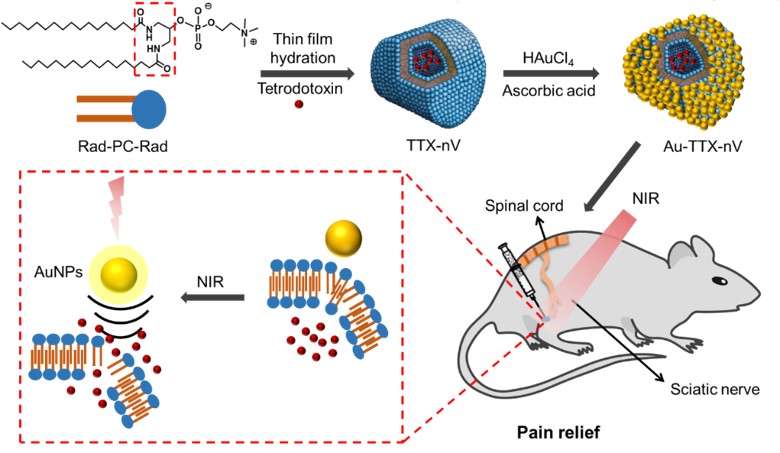Highly photosensitive phospholipid nanovesicles for near infrared light-triggered local anesthesia
Dr. H. Xiong1), University of Texas at Dallas/USA
Abstract
Inadequate postoperative pain management is a common clinical issue for patients to optimize postoperative outcomes and enhance functional recovery after surgery.1) Locally injected anesthetics are effective in perioperative and other forms of acute pain, but they present fast systemic absorption leading to short duration and risk of systemic toxicity.2)3)
Herein, we propose a highly photosensitive nanovesicle to achieve repeatable and adjustable on-demand local anesthesia in superficial or deep tissues, which consists of gold nanoparticles attached to mechanoresponsive liposomes (Figure 1). The mechanoresponsive liposomes will be made from an artificial 1,3-diamidophospholipid. A local anesthetic, tetrodotoxin will be encapsulated in the liposome. Near-infrared (NIR) laser pulses can activate the gold-coating to create nanomechanical stress to break the packing defects, leading to the efficient cargo release.4)5) We will use two models to test the infiltration local anesthesia and regional anesthesia over three days at different laser pulses and energy. The outcome of this study will not only develop a new kind of photosensitive phospholipid liposome, but also contribute to the on-demand, personalized local anesthesia and pain management.

Figure 1. Schematic illustration of preparation of tetrodotoxin-loaded gold-coated mechanoresponsive nano-vesicles (Au-TTX-nV) and NIR light-triggered local anesthesia. TTX-loaded mechanoresponsive nanovesicles (TTX-nV) will be prepared from Rad-PC-Rad lipid by thin film hydration method. Gold nanoparticles will be decorated on the surface of liposomes by the reduction of gold chloride. Au-TTX-nV will be injected at sciatic nerve and triggered by NIR light to release TTX for on-demand pain relief.
Benefit for the community
This work aims to develop new highly photosensitive liposomal local anesthetics for adjustable on-demand postoperative pain management. This work has several benefits for the scientific community and broader phospholipid industry.
- Firstly, the efficient photo-release from this gold-coated mechanoresponsive nanovesicles provides better understanding of this innovative lipid molecule and the membrane structure.
- Secondly, the strategy of gold coating to make near infrared (NIR) photosensitive liposomes provides a new way to prepare externally triggered drug delivery systems.
Visit the supervisors lab
The history and progress of local anesthesia: multiple approaches to elongate the action
J. Anesth. 32, 632-636
| PubMed |
Ultrafast near-infrared light-triggered intracellular uncaging to probe cell signaling
Adv. Funct. Mater. 27, 1605778
| PubMed |
Near-infrared light triggered-release in deep brain regions using ultra-photosensitive nanovesicles
Angew. Chem. Int. Ed. - published online
| Wiley |
Probing Neuropeptide Volume Transmission In Vivo by Simultaneous Near-Infrared Light-Triggered Release and Optical Sensing
Angew. Chem. Int. Ed. 61, e202206122
| PubMed |


